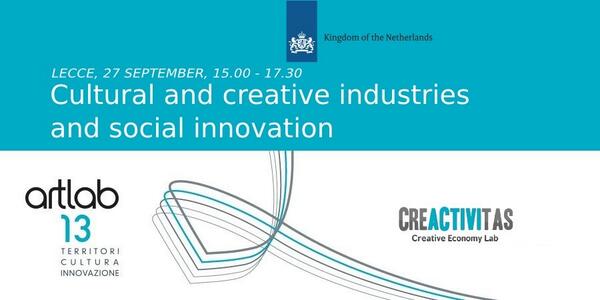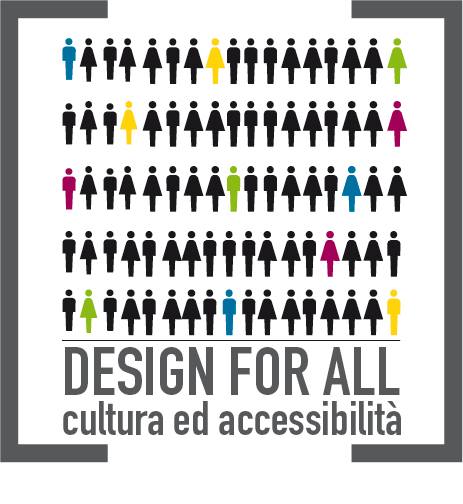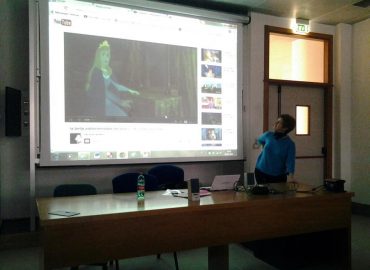An intense and dynamic moment comparing European experiences promoted by the Embassy Kingdom of the Netherlands, in collaboration with Creactivitas, during Art Lab 2013.
Social innovation has been defined in a manifesto published by Waag Society, as “the new strategies, concepts, ideas, organizations that strive to provide solutions for serious social challenges, from job opportunities and education to health care, social engagement and environmental problems”. Obviously, cultural and creative industries are strictly tied to this concept, and the panel aims to illustrate, through a series of experiences throughout Europe, how culture can contribute to various aspects of social innovation. Among other things, they focus on the necessary conditions for social innovation through culture, the opportunities of European collaboration and the social innovation in rural and urban contexts.
The session was opened by Bas Ernst, Senior Cultural Officer of the Netherlands Embassy in Rome, who illustrated the objectives of the panel. After his introduction he handed over the microphone to the moderator, Fabio Borghese, Director of the CreActivitas Lab, who explained the concept of social innovation and the scientific context of the discussion. Social innovation is a process that has the individual at its center and has the aim to improve people’s quality of life. Culture is closely connected with social innovation, because the main agents are the cultural and creative industries, which are important drivers for economic and social innovation. The process of culture driven social innovation takes place using culture and creativity as primary agents in the methodology, sense making, innovation and design, used as a tool for strategic thinking.
The first speaker was Giovanna Garzotto of No Limita-c-tion, a project of the Operaestate Festival at Bassano Del Grappa, one of the most important festivals dedicated to performing arts in Italy. The main objective of her project is to use contemporary dance for social innovation. Her dance workshops and laboratories are developed for people who are seemingly unable to dance because of physical problems, for example, for people with the Parkinson disease. The project demonstrates that dance can contribute successfully to the rehabilitation of patients, underlining how art can be a useful agent for social innovation.
Bart Tunnissen presented some of the main activities of the Waag Society in Amsterdam, a media lab for art, science and technology. The Waag Society research projects start from understanding the needs of society, trying to find solutions by using ideas and creativity from the arts, sciences and technologies. Their researches deliver prototypes that can be tested and developed further, to eventually be put on the market. In their work process, users participate as designers from the early stages, through a process that has as objective to make people understand products and production by sharing knowledge and the means of production. One of the striking projects of Waag Society is the “Fairphone”, which is the world’s first fair trade mobile phone. This phone delivers social innovation because of its combination of technology and sustainability, responding to one of the main challenges of our time.
The third speaker was Daniele Del Pozzo, director of Gender Bender, a festival that addresses gender issues and sexual orientation through culture. They use performing arts as a tool for creating social cohesion and, consequently, social innovation. He illustrated in particular a two year European multi-disciplinary project called Performing Gender in which gay/lesbian and regular performing art festivals and museums work together with choreographers and dancers to investigate the relation between arts and gender issues.

The first group discussion was led by Roy Van Dalm, an expert on smart cities. Social innovation is crucial to the development of smart cities. He compares cultural operators to chefs and asked the participants what they thought was the secret ingredient for generating social innovation. Particularly interesting was the answer given by Bart Tunnissen, who said that the crucial thing to do is trying to change the people’s habits and not focusing on trying to change their minds.
Kaat Peeters of De Sociale InnovatieFabriek in Belgium focused on the question how cultural projects may generate social innovation. De Sociale InnovatieFabriek tries to promote, stimulate and facilitate social innovation and entrepreneurship, by focusing on social challenges, such as poverty, climate change and urbanization. According to Kaat Peters, cultural projects play an important role in social innovation and social development, because they are able to activate people, reconfiguring social relations and empowering the community. To illustrate this, she presented the main culture-related project of the Sociale InnovatieFabriek, called the “The Voice of Our History”, a co-operation between the association Koor&Stem, ‘Choir&Voice’, and a local dementia expertise center. The project entails the improvement of the lives of dementing people by involving them in a singing project.

Philip Delamere represented the Leitrim County, a small city in Ireland, and explained how culture can bring about social innovation in rural areas. One of their most interesting projects is SPARK, a series of creative residencies for local artists to bring them in contact with companies who desire to promote themselves in a creative way, paving the way for cooperation between the artists and the companies. The series of residencies created several projects, from a book of tales to a cd with traditional songs of the Leitrim County.
Another participant was Jean Hurstel, who represented his project Le Banlieues d’Europe from Lyon, France. Hurstel has done many socially innovative projects in suburbs, where social conditions tend to be worse than in other areas. For Hurstel, social innovation goes hand in hand with cultural innovation. He uses cultural projects to develop an area, in order to, consequently, improve the local people’s life quality. He is convinced that the local people learn from the artists in the same way as the artists do from the people of that area.
Erminia Sciacchitano summarized the day by stating that creativity is the winning card. Moreover, culture is a powerful instrument to increase the people’s quality of life. Cultural and creative industries can be successful in both urban and rural contexts, and they may contribute to developing an area by using the concepts of sustainability, social cohesion, innovation and creativity. Put together in the right way, these aspects will generate social innovation.
So, in conclusion, what we can learn about social innovation and its relationship with culture and creativity? Culture is a powerful instrument to increase people’s quality of life. Cultural and creative industries can work with success in both urban and rural contexts, and they are the basis of a new developing of an area using the concepts of sustainability, social cohesion, innovation and creativity. If all these aspects work correctly and mixes well between them, the result it will always be social innovation!
Fabio Borghese
Franco Cappuccio
Alessia De Stefano
Danilo Donnabella
Maria Rossella Scarpa
Useful Links:
You can find our interactive board at this link:
Inside you can find all our storytelling of the day, discussants presentations and Storify where you can find tweets, photos and everything related to the panel and its discussants.






